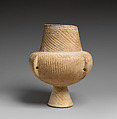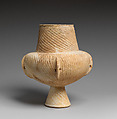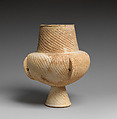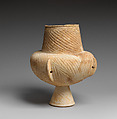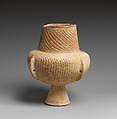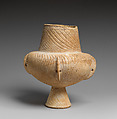On loan to The Met The Met accepts temporary loans of art both for short-term exhibitions and for long-term display in its galleries.
Marble vase with high foot and lug handles
Technical Analysis: Ultraviolet-induced visible luminescence examination, optical microscopy
This white marble collared jar is nearly intact with some loss at the upper neck and mended losses at the rim. It has a tall conical neck that slightly tapers upward and a wide mouth with a thick rounded rim that projects outward. Two horizontal bands delineate the rim from the rest of the neck. The body has somewhat flattened shoulders and a hemispherical to conical shape. It sits atop a high conical foot with a thick, rounded edge, the top of which is delineated by a shallow groove. The underside of the foot is carved concave. The four long, vertical, crescent-shaped lugs, carved crosswise at equidistance, are pierced at the same level for an even suspension. This type of vessel is often dubbed “kandila” as it resembles oil lamps of this name used in the Greek Orthodox Church.
A freely rendered, incised decoration resembling waves covers the exterior surfaces. Parallel oblique incisions decorate the neck and foot, and more vertical curvilinear incisions embellish the body. On account that they are freely executed, some lines are shorter and straighter near the lugs. Traces of uneven circular striations are noticeable in the interior. The large size of this vessel fits within the range of its type. It has been described as an early mature work of Kandila Sculptor A and possibly from Naxos.(1) However, it is the only known marble example of this type with such an incised decoration. Its closest parallel in size is a kandila in the Canellopoulos Museum in Athens.(2) Within the Stern Collection of Cycladic Art, L.2022.38.36, .72 and .110 are of similar size.
A large opaque fill (14 cm in length) at the rim and several smaller fills are visible in transmitted and ultraviolet light. The surface is partially covered with a roughly textured, pale-brown accretions. A ring of dark grey accretions is visible on the interior of the neck. There are scattered old and more recent-looking abrasions on the surface.
Georgios Gavalas and Linda Borsch
(1) See Getz-Gentle, Pat. 1996. The Stone Vessels of the Cyclades in the Early Bronze Age. pp. 5-39, University Park: The Pennsylvania State University Press. (2) See A62 (Athens, Canellopoulos Museum, inv. no. 1158) in Getz-Gentle, Pat. 1996. The Stone Vessels of the Cyclades in the Early Bronze Age. p. 244, University Park: The Pennsylvania State University Press; See also Choremi Spetsieri, Alkistis and Angelos Zarkadas, eds. 2006. The Paul and Alexandra Canellopoulos Museum: Ancient Art. cat. no. 6, p. 24; and Rambach, Jörg. 2000. Kykladen I, Die Frühe Bronzenzeit Grab- und Siedlungsbefunde. Athens NAM 4760, Paros, Glypha Grave 22, Bonn: R. Habelt.
#1332: Marble vase
This image cannot be enlarged, viewed at full screen, or downloaded.
This artwork is meant to be viewed from right to left. Scroll left to view more.
